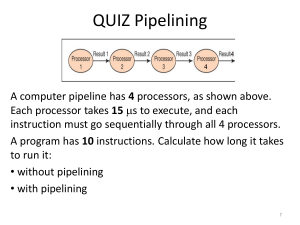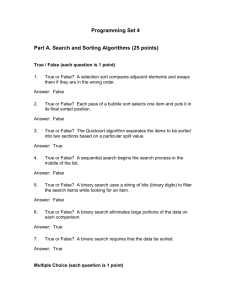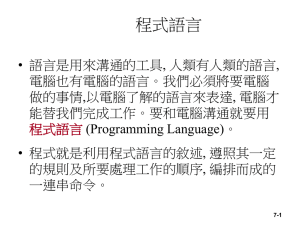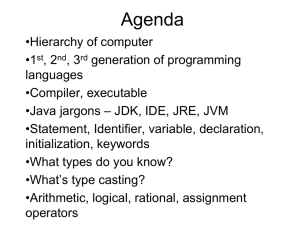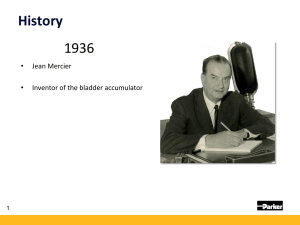Chapter6.ans
advertisement
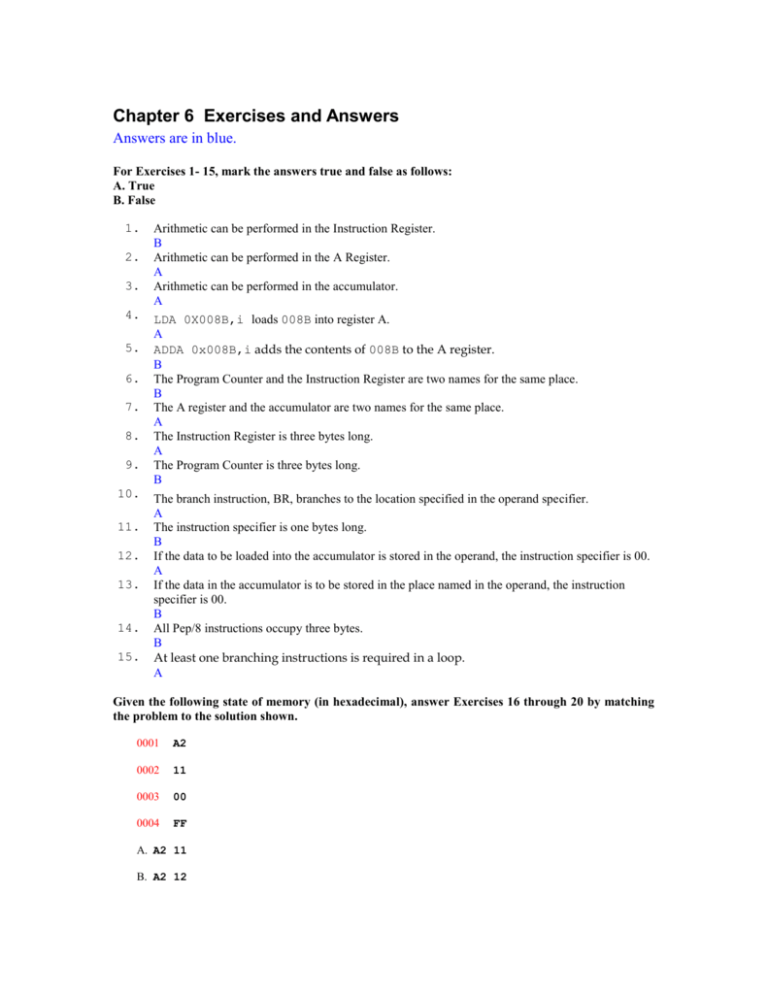
Chapter 6 Exercises and Answers Answers are in blue. For Exercises 1- 15, mark the answers true and false as follows: A. True B. False 1. 2. 3. 4. 5. 6. 7. 8. 9. 10. 11. 12. 13. 14. 15. Arithmetic can be performed in the Instruction Register. B Arithmetic can be performed in the A Register. A Arithmetic can be performed in the accumulator. A LDA 0X008B,i loads 008B into register A. A ADDA 0x008B,i adds the contents of 008B to the A register. B The Program Counter and the Instruction Register are two names for the same place. B The A register and the accumulator are two names for the same place. A The Instruction Register is three bytes long. A The Program Counter is three bytes long. B The branch instruction, BR, branches to the location specified in the operand specifier. A The instruction specifier is one bytes long. B If the data to be loaded into the accumulator is stored in the operand, the instruction specifier is 00. A If the data in the accumulator is to be stored in the place named in the operand, the instruction specifier is 00. B All Pep/8 instructions occupy three bytes. B At least one branching instructions is required in a loop. A Given the following state of memory (in hexadecimal), answer Exercises 16 through 20 by matching the problem to the solution shown. 0001 A2 0002 11 0003 00 0004 FF A. A2 11 B. A2 12 C. 00 02 D. 11 00 E. 00 FF 16. What are the contents of the A register after the execution of this instruction? C1 00 01 17. A What are the contents of the A register after the execution of this instruction? C1 00 02 18. D What are the contents of the A register after the execution of the following two instructions? C0 00 01 70 00 01 19. C What are the contents of the A register after the execution of the following two instructions? C1 00 01 70 00 01 B 20. What are the contents of location 0001 after the execution of the following two instructions? C1 00 03 E0 00 01 E Exercises 21 - 60 are programs or short answer questions. 21. 22. 23. 24. 25. 26. 27. 28. What does it mean when we say that a computer is a programmable device? Programmable means that data and instructions are logically the same and are stored in the same place. The consequence of this fact is that the program the computer executes is not wired into the hardware but entered from outside. List five operations that any machine language must include. There must be machine-language instructions to store, retrieve, and process data, to input data and to output data. These instructions mirror the operations of the von Neumann machine. How many low-level tasks can each machine language instruction perform? A machine language instruction can perform only one low-level task. What is a virtual machine? Discuss this definition in terms of the Pep/8 computer. A virtual machine is a hypothetical machine designed to illustrate important features of a real computer. The Pep/8 computer is a virtual machine designed to illustrate the features of the von Neumann architecture. It has instructions to store, retrieve, and process data as well as instructions to input and output data. How many bits does an instruction take in Pep/8? The instructions in Pep/8 are variable length. Describe the features of the Pep/8 CPU that we covered in this chapter. There is one register for arithmetic and logical operations: the A register (the accumulator). There is a Program Counter that contains the address of the next instruction to be executed and the Instruction Register that contains the instruction being executed. An operand may be immediate (stored in the instruction specifier) or direct (stored in the place named in the instruction specifier). Where is the data (operand) if the address mode specifier is: a. 000 b. 001 a. in the instruction specifier b. in the place named in the instruction specifier We discussed two mode specifiers. How many are there? 29. 30. 31. 32. 33. 8 Distinguish between the IR (instruction register) and the PC (program counter). The IR contains an instruction (the one being executed); the PC contains an address (the address of the next instruction to be executed). How many bits are required to address the Pep/8 memory? The Pep/8 memory contains 65,536 bytes, so 16 bits are required to address each one. How many more cells could be added to memory without having to change the instruction format? Justify your answer. None. The operand specifier could not address more than the current memory. Some Pep/8 instructions are unary, taking only one byte. Other instructions require three bytes. Given the instructions that we have covered in this chapter, would it be useful to define instructions that require only two bytes? The instructions we have covered, other than the Stop instruction, use the operand specifier of the instruction. The operand specifier is two bytes long, so three bytes are required for the instruction: the instruction specifier and the operand specifier. Therefore, two-byte instructions would not be useful. If the input character is A, what is the result of executing the following two instructions? 0001 0004 49 00 06 51 00 06 A is written on the screen. 34. If the input number is 5, what are the contents of the A register after executing the following instructions? 0001 0004 0007 35. 31 00 0F C1 00 0F 70 00 02 7 Write the algorithm for writing out your name, given that the implementation language is Pep/8 machine code. Write "Nell" Write "N" Write "e" Write "l" Write "l" Write "N" Write 4E (hex) Write "e" Write 65 (hex) Write "l" Write 6C (hex) 36. 37. Write "l" Write 6C (hex) Write the machine-language program to implement the algorithm in Exercise 35. 50 00 4E 50 00 65 50 00 6C 50 00 6C zz Write the algorithm for writing out your name, given that the implementation language is Pep/8 assembly language. Write "Nell" Write "N" Write "e" Write "l" Write "l" 38. 39. 40. 41. Write the assembly-language program to implement the algorithm in Exercise 37. CHARO 0x004e,i ;Output 'N' CHARO 0x0065,i ;Output 'e' CHARO 0x006C,i ;Output 'l' CHARO 0x006C,i ;Output 'l' STOP .END Rewrite the machine language program in 6.4, using direct addressing. Direct addressing requires the ability to store values into the addresses from which you are to extract values. We did not cover this in the text. If you went to Pep/8 documentation and found a way to do this, more power to you. Distinguish between the Pep/8 menu options Assemble, Load, and Execute (run). Assemble translates the assembly language program into machine code. Load puts the program into memory ready to be executed. Execute executes the loaded program. The following program seems to run, but does strange things with certain input values. Can you find the bug? sum: num1: num2: num3: Main: 42. BR .WORD .BLOCK .BLOCK .BLOCK LDA DECI DECI DECI ADDA ADDA ADDA STA DECO STOP .END Main 0x0000 1 1 1 sum,d num1,d num2,d num3,d num3,d num2,d num1,d sum,d sum,d One byte of storage is set up for each input value. If the value that is read is grater than one byte, the excess spills over to the byte above giving the wrong answer. Correct the code in Exercise 41 and run the test plan outlined in the Chapter. sum: num1: num2: num3: Main: BR .WORD .BLOCK .BLOCK .BLOCK LDA DECI DECI DECI ADDA ADDA ADDA STA DECO Main 0x0000 2 2 2 sum,d num1,d num2,d num3,d num3,d num2,d num1,d sum,d sum,d STOP .END 43. 44. 45. The test plan gives the correct answers with this code. Finish executing the test plan for the algorithm in the text that reads and sums three values. The answers are correct. Write a pseudocode algorithm that reads in three values and writes out the result of subtracting the second value from the sum of the first and the third values. Read num1 Read num2 Read num3 Load num1 Add num3 Sub num2 Store in answer Write answer Implement the algorithm in Exercise 44 as an assembly-language program. BR sum: num1: Main .WORD 0x0000 .BLOCK 2 num2: .BLOCK 2 num3: .BLOCK 2 answer:.BLOCK 2 Main: DECI num1,d DECI num2,d DECI num3,d LDA num1,d ADDA num3,d SUBA num2,d STA answer,d DECO answer,d STOP .END 46. Write and implement a test plan for the program in Exercise 45. Reason for Test Case Input Values Expected Output Observed Output Assumption: Input values are no greater than 2 -1 or less than – 2 . 15 Input three positive numbers -1 -1 Input three negative numbers -4, -6, -1 1 1 Input mixed numbers 4, 6, -1 -3 -3 4, -6, 1 11 11 4, -6, -1 -9 -9 -4, 6, 1 -9 -9 -4, 6, -1 -11 -11 -4, -6, 1 3 -3 32767, -1, +1 overflows overflows 32767, 1, -1 32767 Large numbers 4, 6, 1 15 47. 48. 49. 50. 51. 52. 53. Design and implement in assembly language an algorithm that reads four values and prints the sum. Set count to 0 Set sum to 0 WHILE count < 4 Read num Add num to sum Set count to count + 1 Write sum BR Read ;branch to location Read sum: .WORD 0x0000 ;set word to zero count: .WORD 0x0000 ;set up a two byte block for count limit: .WORD 0x0004 ;set up a block for value 4 number:.BLOCK 2 ;set up word for value read Read: LDA sum,d DECI number,d ADDA number,d STA sum,d ;store accumulator in sum LDA count,d ;load a copy of limit in accumulator ADDA 1,i STA count,d ;store contents in count CPA limit,d ;compare accumulator to 0 BREQ Quit ;branch to Quit if count is 4 BR Read ;go back to read in another number Quit: DECO sum,d STOP .END Is the test plan for a machine language program valid for the same solution written in assembly language? Explain your answer. A data-coverage plan is written without looking at the code, so the same test plan would be valid. A code-coverage plan looks at the code, but because there is a one to one relationship between a machine code instruction and an assembly language instruction, the same test plan would be valid. Distinguish between the pseudo-code instructions .BLOCK and .WORD. The pseudo-code instruction .BLOCK takes a decimal argument and sets aside that many bytes of storage and set them to zero. A .WORD pseudo-code instruction takes a decimal argument and generates one word of storage with the decimal value stored in it. Distinguish between assembly language pseudo-code instructions and mnemonic instructions. Pseudo-code instructions are instructions to the assembler; mnemonic instructions are to be translated by the assembler. Distinguish between test plans based on code coverage and data coverage. A code-coverage test plan is based on examining and covering the statements in the code. A datacoverage test plan is based on the input data to the program. What button on the Pep/8 console must be pushed for keyboard input? Terminal I/O Write the Pep/8 assembly language statement for the following instructions. a. Branch to location Branch1 if the accumulator is zero. BREQ Branch1 b. Branch to location Branch1 if the accumulator is negative. BRLT Branch1 c. Branch to location Branch1 if the accumulator is negative and to Branch2 if accumulator is not negative. BRLT Branch1 Branch2: That is, go to location Branch1 if the accumulator is negative. If the accumulator is not negative, the next instruction is executed, so it must be labeled Branch2. 54. 55. Write a pseudocode algorithm to read in a name and write a “Good morning” message. Write "Enter a Name" Read name Write "Good morning", name Write a pseudocode algorithm to get three integers from the user and print them in numeric order. Write "Enter three integer values" Read first, second, third IF (first < second) IF (second < third) Write first, second, third ELSE IF (first < third) Write first, third, second ELSE Write third, first, second ELSE IF (first < third) Write second, first, third ELSE IF (second < third) Write second, third, first ELSE Write third, second, first 56. Enclose the design in Exercise 55 within a loop that reads in the three values until the user enters the first value of the trio as negative. Write "Enter three values; a negative value stops the processing" Read first, second, third WHILE (first > 0) // Process the three values Write "Enter three values; a negative value stops the processing" Read first, second, third Rewrite the algorithm in Exercise 56 so that the user has to enter only one negative value to stop (that is, the second and third values are not entered). Write "Enter three values; a negative value stops the processing" Read first WHILE (first > 0) Read second, third // Process the three values Write "Enter three values; a negative value stops the processing" Read first 58. Distinguish between pseudocode and pseudo-operations. Pseudocode is a language for expressing algorithms. Pseudo-operations are instructions to a translating system. 59. What are the constructs that pseudocode must be able to express? Variables, assignment, input/output, repetition, selection (if-then, if-then-else) 60. Distinguish between the looping construct and the selection construct. A looping construct repeats an action (s) while a condition is true. A selection construct determines if a condition is true and does one thing if it is and another thing if it is not.

